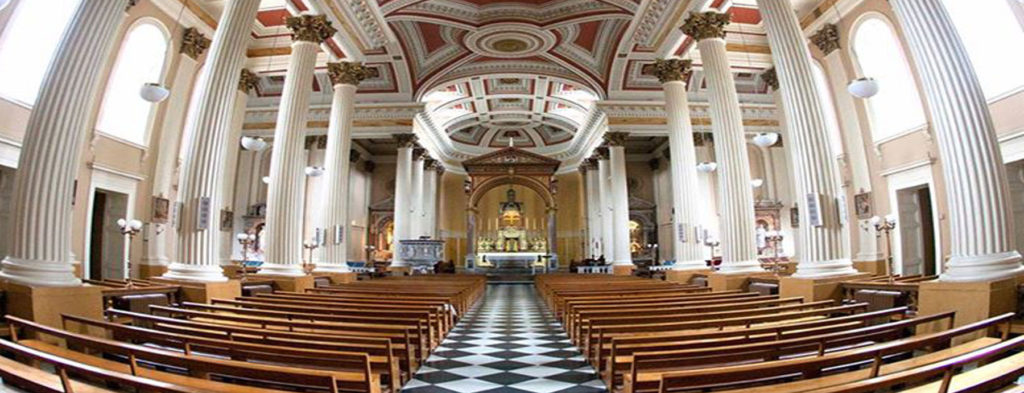
Church Building
Structure
The main structure was built between 1832 – 1839. The portico was erected in 1891, its fluted Ionic columns standing more than ten metres high, on a flight of ten steps.
Between 1868 and 1872, a major structural change was made to the sanctuary. The solid rock behind the church was excavated, and the present apse constructed. All the elements of the sanctuary were designed by George Goldie.
Interior
Gas for lighting the church was used for the first time on Christmas morning 1855, but the brass gas standards (now fitted with electric lighting) were not put in place until 1885.
The coffered ceiling was executed by local craftsmen at a time when such sophisticated plaster work was normally undertaken only by Italians
The former Stations of the Cross, oil paintings from 1872, were replaced in 1969 by the present Stations, which were hand-carved in Italy.
The Reredos occupies the full space between the two columns at the rear of the baldachino. Its centrepiece is a model of the Holy of Holies, the innermost part of the ancient temple in Jerusalem. At the sides are marble statuettes of St Thomas Aquinas and St. Rose of Lima. This marble structure houses the Tabernacle, of brass and blue enamel, designed in 1883 and made in Paris. At either side of it are brass statuettes of St Dominic and St. Catherine of Siena.
The high altar is the third since the church was constructed. To facilitate the celebration of the liturgy according to the second Vatican Council, the present altar was detached from the reredos in 1976, re-inforced, and brought forward 1.1 metres.
Towering above the altar is the Baldachino, erected in 1872. Its four columns are made of polished red Aberdeen granite, each shaft consisting of a single piece 3.4 metres high, resting on bases of Sicilian white marble. Each pedestal has four panels of green Connemara marble. The columns are crowned with elaborately foliated capitals of Caen stone. At the front of the baldachino are the words “VERE TU ES DEUS ABSCONDITUS” (truly you are a hidden God – Isaiah 45:15). Above the pillars at each corner are statues of the four Latin doctors of the church : St Ambrose & St Augustine at the back, St Jerome and St Gregory the Great at the front.
The pulpit, from 1830, is made of several kinds of marble: Carrara, Sicilian, Siennese, Galway Black, and Midleton Red. The figures represented on it are those of five Dominican saints : St. Dominic, St. Thomas Aquinas, St. Catherine of Siena, St. Pius V, and St. Vincent Ferrer.
The shrine of Our Lady of Graces (on the right of the sanctuary facing up) contains a small ivory image with a long history. In 1304, this image was brought from the continent to Ireland by Maurice O’Carroll, a Dominican archbishop of Cashel. When he died in 1316, he was laid to rest in the Dominican church in Youghal (one gable wall of which still stands), and the image which he had much venerated was interred with him. A century later, the image was removed from the tomb and soon became an object of great veneration. During the reign of Elizabeth I the church was destroyed and the image came into the possession of Honoria Fitzmaurice Fitzgerald. It was she who had it enclosed in the silver reliquary where it still lies. When the Dominicans left Youghal towards the end of the 18th century, the image was brought to Cork and placed in a larger shrine. The whole was placed in its present position on the Rosary altar in 1895.
On the opposite side of the sanctuary, under St Dominic’s altar, are the relics of St. Severus, an early Christian martyr, placed here in 1842. His memory is honoured annually on December 11. The inscription, reminiscent of the martyrs in the Roman catacombs, reads SEVERO IN PACE (to Severus, who is in peace).